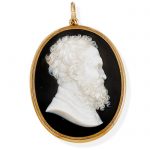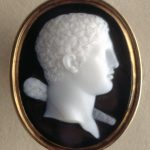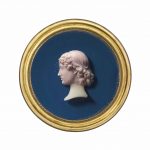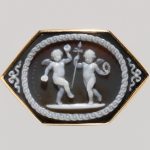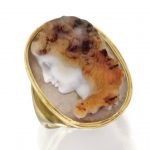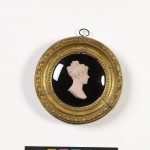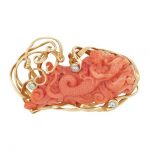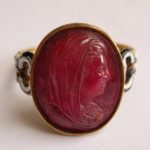Giovanni Antonio Santarelli was a sculptor / medallist and gem engraver. He was also known as Santarelli, Giovanni Antonio.
Giovanni Antonio Santarelli (1769-1826), a highly skilled Italian gem engraver and medallist, worked as engraver to Mints of Milan and Parma, also becoming a professor at the Academy in Florence where he lived most of the latter part of his life. Santarelli is reported to have worked with the Pichlers, another well-known family of Italian gem engravers. Reference: Sotheby’s.
An onyx cameo portrait, by Giovanni Antonio Santarelli, late 18th/early 19th century Oval, the cameo portrait of a gentleman carved in onyx, facing right, within a gold pendant frame, signed Santarelli, cameo: length 3.7cm, width 2.9cm, pendant: length 4.9cm, width 3.2cm
Sold for £ 12,500 inc. premium at Bonhams in 2017
Cameo; onyx; head of young Hercules to right; behind the neck, the club, on which is engraved a signature. Engraved by: Giovanni Antonio Santarelli biography Date18thC-19thC
Reference: © The Trustees of the British Museum
GIOVANNI ANTONIO SANTARELLI (ITALIAN, 1756-1826) A wax profile of a young girl in profile to left, on a blue glass ground wax and glass 2½ in. (65 mm.) diam., gilt-metal mount in square wood frame
Sold for GBP 812 at Christies in 2013
Dancing Amorini with Bacchic symbols Date:late 18th–early 19th century
The mild gray ground is a foil for delicate movement and ornament. Giovanni Santarelli’s original wax-on-slate model (Museo Nazionale del Bargello, Florence) is oval. He expanded the compositional field onto a wider hexagon, from the outset sensing its suitability for a ring.
Reference: The Metropolitan Museum of Art
Gold and Hardstone Cameo Ring, Giovanni Antonio Santarelli, Late 18th Century to Early 19th Century The hardstone cameo featuring the bust of Herakles or Omphale (in his guise) facing left, wearing the lion skin headdress, paws crossed at the neckline, the hardstone cameo signed Santarelli, size approximately 6½.
The subject in the example offered here presents a feminized portrait of Herakles, who according to Greek mythology became the slave of Omphale (Queen of the kingdom of Lydia) and was made to dress in women’s clothes, do women’s work, and hold the basket for the wool spun by Omphale and her maidens. Conversely, the portrait could also represent Omphale as she is often portrayed in the guise of Herakles because legend has it that she donned Herakles’ attributes of the lion skin headdress and brandished the club with which he slayed the Nemean Lion.
Sold for 27,500 USD at Sothebys in 2011
Relief in pink wax on glass ground. The subject is seen in right profile. She wears an earring. Her hair, which is dressed in tight curls in front, is adorned with a jewelled comb at the back. On the back of the circular frame is an old label with an inscription
This medallion relief representing an unknown woman is made by Giovanni Santarelli, in Italy in the early 19th century. Santarelli, who was in Rome from 1785-1797 and was a friend of Canova and of Pichler, spent most of his life in Florence, where he was Professor at the Academy. He worked also for the Mint in Milan and in Parma. Santarelli was well known as a gem-cutter, wax-modeller, medallist and sculptor.
Reference: © Victoria and Albert Museum
